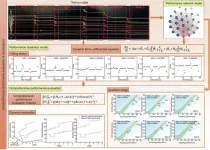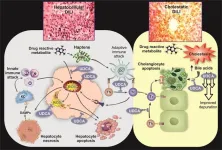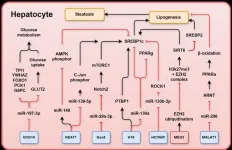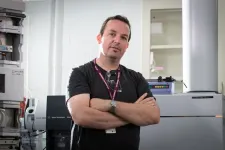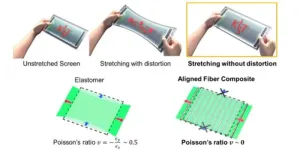(Press-News.org) Paul Armsworth, Distinguished Service Professor in the Department of Ecology and Evolutionary Biology at the University of Tennessee, Knoxville, has received a 2025 Southeastern Conference Faculty Achievement Award for excellence in teaching, research and service.
He and the 15 other recipients this year — one from each SEC member university — are now nominated for the SEC Professor of the Year Award, which will be announced later in the spring.
“I am thrilled to receive this recognition, but it is also very humbling to be celebrated in this way because all science, and ours in particular, is a team sport,” said Armsworth, who joined UT in 2009. “My students and colleagues here at UT and at other universities who work with us on conservation questions, as well as our partners in conservation practice, are the source of new research questions and ideas. They’re the ones who implement our research and are doing the critical work to protect species and ecosystems on which we all depend.”
“Dr. Armsworth exemplifies UT’s commitment to excellence in research, teaching and service and is a deserving recipient of the SEC Faculty Achievement Award,” said Provost and Senior Vice Chancellor John Zomchick. “This recognition reflects his profound impact on both his field and our academic community.”
It is Armsworth’s interdisciplinary approach to conservation biology that makes him stand out, said Kate Jones, professor and divisional dean of natural sciences and mathematics within UT’s College of Arts and Sciences.
“Dr. Armsworth sees connections between the natural world and humans and looks at all aspects of conservation biology in a very interconnected way,” she said. “His research bridges ecological and economic dimensions of conservation, considering disparate but intertwined issues such as public support for conservation, data relating to species locations and the management required to support their survival. These issues become significant when protected areas attract development, or a decision needs to be made to protect sites that may be costly but in immediate danger over more remote sites that may be cheaper to acquire.”
Inside the classroom, Armsworth exemplifies an experiential style of teaching that makes him a favorite among students, Jones added. He brings professionals from a broad swath of conservation careers to his class and offers exceptional research experiences to undergraduates in addition to mentoring graduate students and postdoctoral fellows in his lab.
“We integrate research into the classroom, we integrate students into our research and everything we do is in service of improving conservation efforts,” Armsworth said. “Students learn about the science-to-policy interface. Meanwhile, those students are applying what they’re learning to projects that are supporting our state and NGO partners as they develop conservation plans in the real world.”
The work benefits both the mountains of East Tennessee and the greater Southeast.
“Here in our region, we are in a biodiversity hotspot,” Armsworth said. “We have unique species that are found nowhere else on the planet. That means we carry disproportionate responsibility for the protection of some groups such as salamanders, mussels and crayfishes.”
Protecting ecosystems provides important benefits not just to flora and fauna but to people throughout the region as well — from offering recreation opportunities to helping purify water to sequestering carbon to improve air quality.
“And all of that is all very interdisciplinary,” Armsworth said. “The world is an interdisciplinary place. So we are chasing ecological questions. We’re using mathematical, computational, statistical approaches. We’re weaving spatial data. We’re collaborating with economists and public policy experts. We’re working with environmental anthropologists talking with communities in these regions.
“We couldn’t approach these things without that combination, that coming together of disciplines,” he added. “It is done with and for partners, and it also couldn’t be done without them.”
For more than a decade, the SEC has used its SEC Faculty Achievement Award to honor faculty. The program was established in 2012 by the conference’s presidents and chancellors.
Previous winners from UT are Alison Buchan, Professor of Microbiology; Elbio Dagatto, Distinguished Professor of Theoretical Condensed Matter Physics; Louis Gross, Distinguished Professor Emeritus of Ecology and Evolutionary Biology; J. Wesley Hines, Postelle Professor and Chancellor’s Professor of Nuclear Engineering; Suzanne Lenhart, Chancellor’s Professor and James R. Cox Professor of Mathematics; Hap McSween, Chancellor’s Professor Emeritus of Earth and Planetary Sciences; Susan Riechert, Distinguished Service Professor and Chancellor’s Professor of Ecology and Evolutionary Biology; Tony Schmitz, Richard Rosenberg Distinguished Professor of Mechanical, Aerospace, and Biomedical Engineering; Daniel Simberloff, Gore Hunger Professor of Environmental Science; Gregory Stuart, Professor of Psychology; Carol Tenopir, Chancellor’s Professor Emeritus of Information Sciences; Leon Tolbert, Chancellor’s Professor of Electrical Engineering and Computer Science; and Penny White, Professor Emerita of Law.
END
Armsworth receives SEC Faculty Achievement Award
2025-02-28
ELSE PRESS RELEASES FROM THIS DATE:
Novel network dynamic approach presents new way for aeroengine performance evaluation
2025-02-28
A recent study published in Engineering presents a groundbreaking method for comprehensively evaluating the performance of aeroengines, the crucial components powering aircraft. Authored by Shubin Si and other researchers from esteemed institutions in China, this research addresses long-standing challenges in aeroengine performance assessment.
Aeroengines are complex systems, and their performance directly impacts flight safety and efficiency. Traditional evaluation methods, such as airlines relying on single-parameter indicators like exhaust gas temperature or manufacturers conducting ...
Gene therapy developed for maple syrup urine disease shows promise, new UMass Chan study reports
2025-02-28
A study led by UMass Chan researchers demonstrated that a gene therapy to correct a mutation that causes maple syrup urine disease (MSUD) prevented newborn death, normalized growth, restored coordinated expression of the affected genes and stabilized biomarkers in a calf as well as in mice.
“Simply put, we believe the gene therapy demonstrated in both animal species, especially in the cow, very well showcases the therapeutic potential for MSUD, in part because the diseased cow, without treatment, has a very similar metabolic profile as the patients,” said Dan Wang, PhD, assistant ...
Ursodeoxycholic acid for the management of drug-induced liver injury: Role of hepatoprotective and anti-cholestatic mechanisms
2025-02-28
Drug-induced liver injury (DILI) is a significant concern in clinical practice, arising from medications, herbs, and dietary supplements. It can manifest in different forms, including hepatocellular, cholestatic, and mixed types, each associated with specific liver enzyme abnormalities and histological injury patterns. Hepatocellular DILI is characterized by inflammation, necrosis, and apoptosis, while cholestatic DILI involves bile plug formation and bile duct paucity. Ursodeoxycholic acid (UDCA), a widely used treatment for cholestatic liver diseases, has recently been investigated for its potential therapeutic effects ...
Hepatic biliary adenofibroma: Histological characteristics, diagnostic challenges, and its role as a precursor to intrahepatic cholangiocarcinoma
2025-02-28
Hepatic biliary adenofibroma (BAF) is a rare benign bile duct neoplasm that has garnered increasing attention due to its potential role as a precursor lesion for intrahepatic cholangiocarcinoma (iCCA). Although it shares histopathological features with other biliary tumors, BAF is distinct in its composition, consisting of low-grade tubuloglandular and microcystic bile duct structures embedded in a dense fibrous stroma. Despite its classification as a benign tumor, emerging case reports suggest that BAF may undergo malignant transformation. However, its rarity and limited molecular characterization contribute to diagnostic ...
Unlocking the role of long non-coding RNAs in liver disease progression
2025-02-28
Metabolic dysfunction-associated steatotic liver disease (MASLD), formerly known as non-alcoholic fatty liver disease (NAFLD), is a global health challenge, affecting nearly 30% of adults worldwide. A significant subset of MASLD patients progresses to metabolic dysfunction-associated steatohepatitis (MASH), liver fibrosis, and even hepatocellular carcinoma (HCC), yet no universally approved treatment exists outside resmetirom. The increasing prevalence of MASLD, driven by obesity and diabetes, highlights an urgent need for innovative therapeutic ...
McMaster researchers uncover blood metabolites that may influence early childhood development
2025-02-28
McMaster University researchers have identified small molecules in the blood that may impact early childhood development, showing how dietary exposures, early life experiences, and gut health can influence a child's growth and cognitive milestones.
A McMaster team collaborated with Brazilian scientists to conduct an untargeted metabolomic analysis of blood samples taken from more than 5,000 children between the ages of six months and five years as part of the Brazilian National Survey of Child Nutrition study.
The McMaster team found several metabolites – small molecules that are by-products of human metabolism and microbial fermentation, ...
Why don’t pandas eat more meat? Molecules found in bamboo may be behind their plant-based diet
2025-02-28
Giant pandas have digestive systems that are typical for carnivores. Yet, bamboo is their main source of food. They have evolved several features, for example pseudo thumbs to grasp bamboo and flat teeth that are well suited for crushing it, that make it possible for them to live off plants.
All living organisms have DNA, which stores the genetic information in a cell, and RNA, which carries and transfers this information. MicroRNAs (miRNA) are small non-coding RNAs that play an important role in gene expression, the process of turning the information encoded in a gene into a function. ...
Development of 'transparent stretchable substrate' without image distortion could revolutionize next-generation displays
2025-02-28
Stretchable display materials, which are gaining traction in the next-generation display market, have the advantage of being able to stretch and bend freely, but the limitations of existing materials have resulted in distorted screens and poor fit. General elastomeric substrates are prone to screen distortion due to the 'Poisson's ratio' phenomenon, in which stretching in one direction causes the screen to shrink in the vertical direction. In particular, electronics that are in close contact with the skin, such as wearable devices, are at risk of wrinkling or pulling on the skin during stretching and shrinking, resulting in ...
Improving the scope of wearable monitors
2025-02-28
By Alistair Jones
SMU Office of Research – Even by the standards of medical terminology, photoplethysmography (PPG) is a mouthful. Yet it is widely used in clinical settings as a non-invasive, optical technique for measuring the oxygen saturation level in the blood, and the pulse rate, as vital signs of a patient. It is commonly encountered as a clip-on oximeter attached to a finger.
First developed in the 1930s, PPG emits light to illuminate the microvascular bed of the skin. Then a photodiode, positioned alongside the light emitter, captures the reflected light, termed the PPG waveform, which ...
Zeroing in: SMU project to boost indoor localization capabilities for the public agencies
2025-02-28
By Vince Chong
SMU Office of Research – With the surfeit of trackable, wearable devices in modern life, there is little problem locating things and people outdoors by leveraging Global Navigation Satellite System (GNSS) solutions (GPS is an example of this type of solution) that use signals from satellites. Indoors on the other hand, is a different matter as GNSS signals are unavailable and other possible signals such as those from Wi-Fi systems are inconsistent, and often distorted.
And when this ability to swiftly, accurately locate indoor objects is starkly crucial to essential services that make the difference between life and death, upgrading ...

